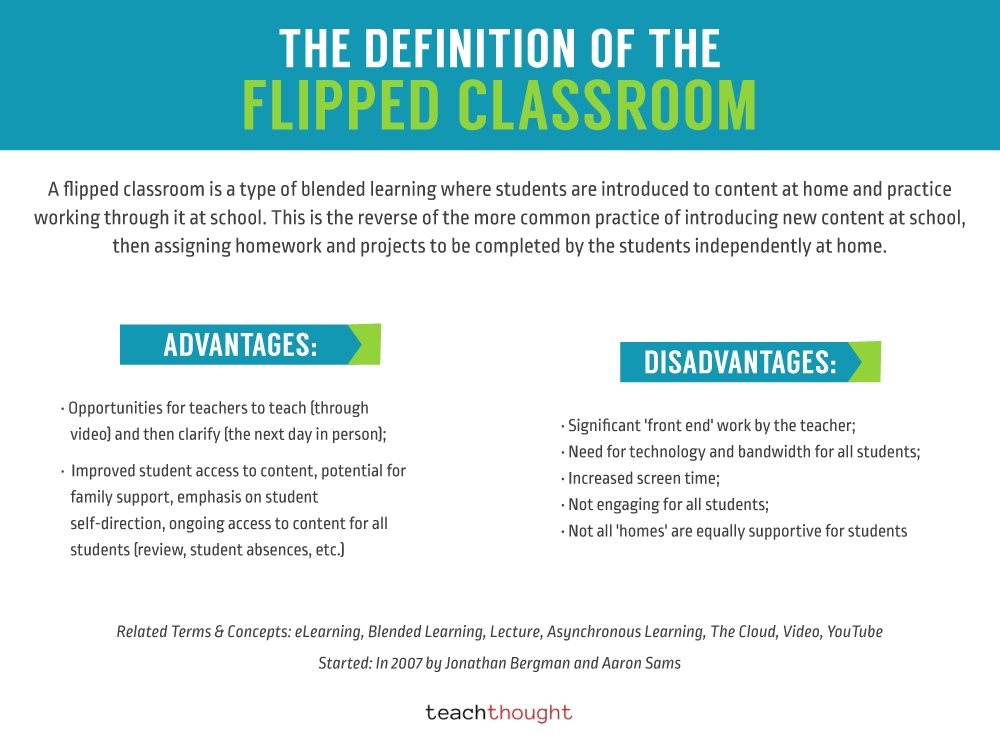The Definition Of The Flipped Classroom
The definition of a Flipped Classroom is to preview new content at home & practice it at school where teachers & peers are available to help.

What Is The Definition Of The Flipped Classroom?
As one of the most popular trends in education in recent memory, you’ve undoubtedly heard of the flipped classroom. But what is it about a classroom that’s been flipped that makes it unique?
A flipped classroom is a type of blended learning where students are introduced to content at home and practice working through it at school. This is the reverse of the more common practice of introducing new content at school, then assigning homework and projects to completed by the students independently at home.
See also The Difference Between Synchronous Learning And Asynchronous Learning
In this blended learning approach, face-to-face interaction is mixed with independent study–usually via technology. In a common Flipped Classroom scenario, students might watch pre-recorded videos at home, then come to school to do the homework armed with questions and at least some background knowledge.
The concept behind the flipped classroom is to rethink when students have access to the resources they need most. If the problem is that students need help doing the work rather than being introduced to the new thinking behind the work, then the solution the flipped classroom takes is to reverse that pattern.
What Do Students Do At Home In A Flipped Classroom?
Watch an online lecture
Review online course material
Read physical or digital texts
Participate in an online discussion
Perform research
What Do Students Do At School In A Flipped Classroom?
Skill practice (guided or unguided by the teacher)
In-person, face-to-face discussion with peers
Debate
Presentations
Station learning
Lab experiments
Peer assessment and review
This doubles student access to teachers–once with the videos at home, and again in the classroom, increasing the opportunity for personalization and more precise guiding of learning. In the flipped classroom model, students practice under the guidance of the teacher, while accessing content on their own.
A side benefit is that teachers can record lectures that emphasize critical ideas, power standards, and even the pace of a given curriculum map. It also has the side benefit of allowing students to pause, rewind, Google terms, rewatch, etc., as well as creating a ready-made library for student review, make-up work, etc.
What Are The Criticisms Of The Flipped Classroom?
Of course, it’s not that simple, and there are pros and cons of a flipped classroom.
As a learning model, criticisms include reduced opportunity for self-directed critical thinking, decentering the role of the student, encouraging a lecture-driven march through curriculum, and in general simply streamlining an already industrialized approach to learning.
And just like in a regular classroom, success depends greatly on the quality of the teacher, the clarity of communication, and the quality of given curriculum, assessment, and instruction. Further, equity is still a major issue, and it doesn’t address the dated approach most educational systems take to curriculum. So there’s that.
What’s The Simplest Way To Think About A Flipped Classroom?
The students do homework at school.
Put another way, students preview content home and then extend learning and/or practice at school.
When Was The Flipped Classroom Invented?
The flipped classroom was invented in 2007 by Jonathan Bergman and Aaron Sams when they began recording their classroom lectures so that students could access them at home.
The Definition Of The Flipped Classroom